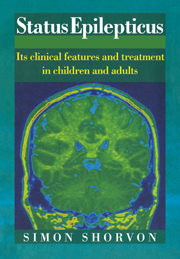Book contents
- Frontmatter
- Contents
- Preface
- 1 The concept of status epilepticus and its history
- 2 Definition, classification and frequency of status epilepticus
- 3 Clinical forms of status epilepticus
- 4 Neurophysiology, neuropathology and neurochemistry of status epilepticus
- 5 Emergency treatment of status epilepticus
- 6 Prognosis and outcome of status epilepticus
- References
- Index
6 - Prognosis and outcome of status epilepticus
Published online by Cambridge University Press: 15 September 2009
- Frontmatter
- Contents
- Preface
- 1 The concept of status epilepticus and its history
- 2 Definition, classification and frequency of status epilepticus
- 3 Clinical forms of status epilepticus
- 4 Neurophysiology, neuropathology and neurochemistry of status epilepticus
- 5 Emergency treatment of status epilepticus
- 6 Prognosis and outcome of status epilepticus
- References
- Index
Summary
Status is … a true climax of the disease [epilepsy] and less a chance termination which by proper treatment could be avoided; certainly chance plays no part as agent in the production of status. An epileptic is foredoomed to die of the status as a maximum development of the disease.
(Clark & Prout 1903/4)Thus Clark & Prout, in true fin de siècle mood, saw the outcome of status; an apocalyptic view which sets the scene for our sombre reflections on prognosis. Neurological thought is often traced back (in Anglo-Saxon if not Gallic texts!) to Hughlings Jackson or Gowers, matchless theoreticians of nineteenth century epilepsy. On the subject of status epilepticus, though, both were almost silent. Jackson gives one case report of a female patient with recurrent status who survived the repeated episodes unharmed, and Gowers commented that he had not personally seen a case. In regard to prognosis in epilepsy, Gowers considered ‘the danger to life in epilepsy is not great. Alarming as is the aspect of a severe epileptic fit — imminent as the danger to life appears when the patient is lying senseless, with livid, swollen and distorted features, and convulsions which almost asphyxiate him, looking “as if strangled by the bow of an invisible executioner” (Radcliffe), it is extremely rare for a patient to die in a fit’ (Gowers 1881).
- Type
- Chapter
- Information
- Status EpilepticusIts Clinical Features and Treatment in Children and Adults, pp. 293 - 312Publisher: Cambridge University PressPrint publication year: 1994
- 7
- Cited by



